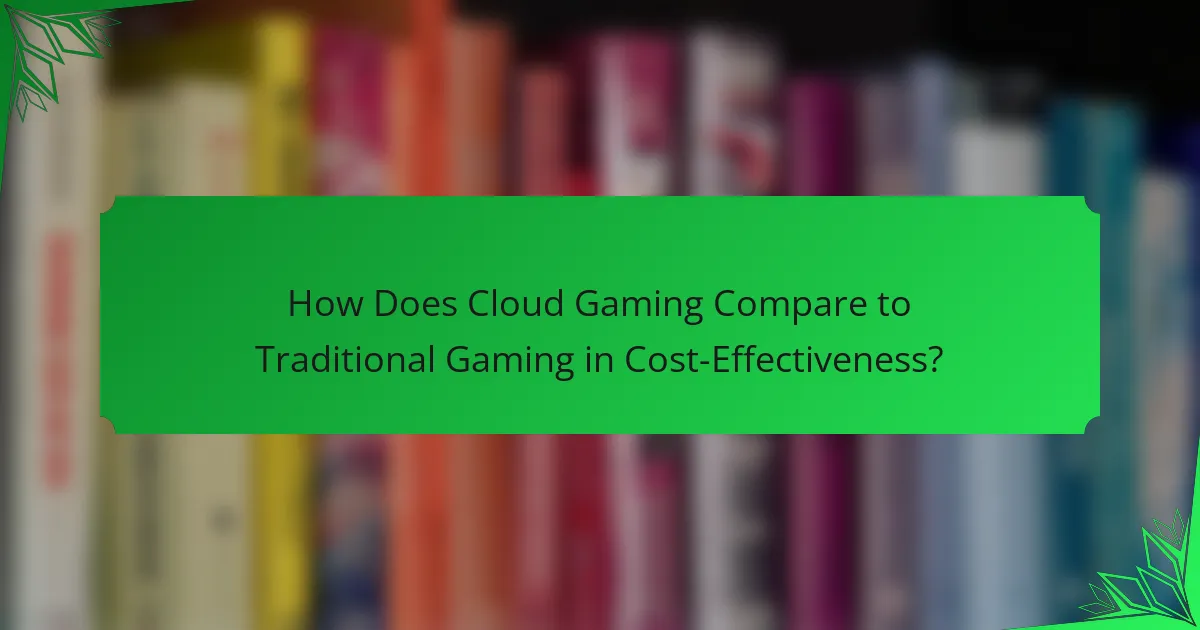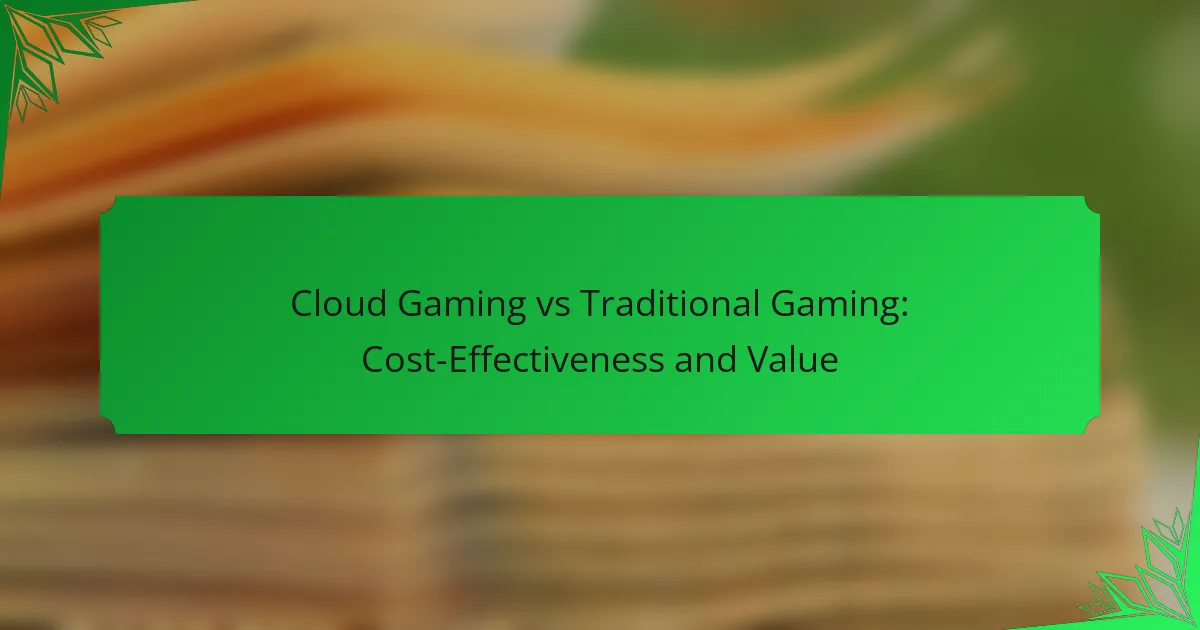As the gaming landscape evolves, the debate between cloud gaming and traditional gaming intensifies, particularly regarding cost-effectiveness and overall value. Cloud gaming presents a budget-friendly alternative, allowing players to enjoy a diverse library without the hefty hardware investments associated with traditional gaming. However, while cloud gaming typically incurs ongoing subscription fees, traditional gaming may lead to lower long-term costs despite higher initial expenses.

How Does Cloud Gaming Compare to Traditional Gaming in Cost-Effectiveness?
Cloud gaming generally offers a more cost-effective option than traditional gaming, especially for those who want to avoid high upfront expenses. Users can access a wide range of games without needing to invest heavily in hardware, making it an appealing choice for budget-conscious gamers.
Lower upfront costs with cloud gaming
Cloud gaming allows players to enjoy games without the need for expensive consoles or high-end PCs. With a stable internet connection, users can stream games directly to their devices, which significantly reduces initial costs. This model is particularly beneficial for casual gamers who may not want to spend hundreds of dollars on hardware.
Many cloud gaming services offer free trials or low monthly fees, making it easier for gamers to try out new titles without a substantial financial commitment. This flexibility can lead to savings, especially for those who play sporadically.
Higher initial investment in traditional gaming
Traditional gaming typically requires a significant upfront investment in hardware, such as gaming consoles or powerful PCs, which can cost several hundred to over a thousand dollars. Additionally, gamers often need to purchase accessories like controllers, headsets, and storage devices, further increasing the initial costs.
Moreover, traditional gaming often necessitates regular upgrades to keep up with new game releases, adding to the long-term expenses. This can be a deterrent for many potential gamers who are looking for a more economical option.
Subscription models in cloud gaming
Many cloud gaming platforms operate on subscription models, allowing users to pay a monthly fee for access to a library of games. This can range from around $10 to $30 per month, depending on the service and the number of titles available. Such models provide gamers with the flexibility to play various games without the need for individual purchases.
Subscription services often include additional benefits, such as exclusive content or early access to new releases, enhancing the overall value for subscribers. However, it’s essential to evaluate which games are included in the subscription to ensure it aligns with personal gaming preferences.
One-time purchases in traditional gaming
In traditional gaming, most titles are sold as one-time purchases, typically ranging from $20 to $70 each. This model can lead to higher costs over time, especially for avid gamers who frequently buy new games. Additionally, some games may require additional purchases for downloadable content (DLC), which can further increase expenses.
While one-time purchases can provide ownership of a game, they lack the flexibility of subscription models. Gamers must carefully consider their gaming habits and budget to determine if this approach is sustainable in the long run.

What Are the Long-Term Financial Implications of Each Gaming Model?
The long-term financial implications of cloud gaming and traditional gaming vary significantly based on ongoing costs, initial investments, and potential savings. While cloud gaming often involves subscription fees, traditional gaming may require upfront purchases but can lead to lower long-term expenses.
Ongoing fees for cloud gaming
Cloud gaming typically requires a monthly or annual subscription fee, which can range from around $10 to $30 per month, depending on the service. This fee grants access to a library of games, but users must remain subscribed to continue playing.
Additionally, some platforms may charge extra for premium titles or in-game purchases, which can add to the overall cost. Users should consider these ongoing expenses when evaluating the long-term value of cloud gaming.
Potential savings with traditional gaming
Traditional gaming often involves a one-time purchase of hardware and games, which can lead to significant savings over time. For instance, a gaming console may cost several hundred dollars, but games can be bought at discounted prices or second-hand, reducing overall spending.
Moreover, once a game is purchased, players can enjoy it indefinitely without additional fees. This model can be more cost-effective for gamers who prefer to invest upfront rather than commit to recurring payments.

Which Gaming Model Offers Better Value for Players?
Cloud gaming generally offers better value for players due to its lower upfront costs and access to a vast library of games. Traditional gaming can provide exclusive titles and a more immersive experience, but it often requires significant investment in hardware and software.
Access to a wider game library with cloud gaming
Cloud gaming services typically provide access to a large library of games for a monthly subscription fee. This model allows players to try various titles without the need to purchase each one individually, which can save money in the long run. For example, platforms like Xbox Cloud Gaming and NVIDIA GeForce Now offer hundreds of games, often including new releases.
Additionally, cloud gaming eliminates the need for high-end hardware, as games are streamed from powerful servers. This means players can enjoy high-quality gaming experiences on lower-spec devices, further enhancing the value proposition.
Exclusive titles in traditional gaming
While cloud gaming offers a broad selection, traditional gaming often boasts exclusive titles that are not available on cloud platforms. Major franchises like “The Legend of Zelda” or “God of War” are typically tied to specific consoles, which can be a significant draw for dedicated gamers. These exclusive games can justify the investment in a gaming console or PC.
Moreover, traditional gaming can provide a more stable and immersive experience, as players are not reliant on internet speeds or connection stability. This can be particularly important for competitive gamers who require low latency and consistent performance.

What Are the Key Factors Influencing Cost-Effectiveness?
The cost-effectiveness of cloud gaming versus traditional gaming hinges on several key factors, including internet speed, hardware requirements, and subscription models. Understanding these elements can help gamers make informed decisions based on their preferences and budgets.
Internet speed and reliability for cloud gaming
Cloud gaming requires a stable and fast internet connection, typically at least 15 Mbps for standard quality and 25 Mbps for high definition. Latency is also crucial; low latency (under 30 ms) enhances the gaming experience, while higher latency can lead to lag and frustration.
Gamers should consider their internet service provider’s reliability and whether they experience frequent outages. A wired connection is often more stable than Wi-Fi, making it a better choice for cloud gaming.
Hardware requirements for traditional gaming
Traditional gaming often necessitates significant investment in hardware, including a powerful gaming console or PC, which can cost hundreds to thousands of dollars. Additionally, gamers may need to upgrade components like graphics cards and processors to keep up with new game releases.
In contrast, cloud gaming reduces the need for high-end hardware since the processing is done on remote servers. This can lead to lower initial costs, but ongoing subscription fees and potential data usage charges should be factored into the overall cost analysis.

How Do Player Preferences Affect Gaming Choices?
Player preferences significantly influence gaming choices, determining whether individuals lean towards cloud gaming or traditional gaming. Factors such as gaming style, budget, and hardware access play crucial roles in shaping these decisions.
Casual gamers favor cloud gaming
Casual gamers often prefer cloud gaming due to its accessibility and convenience. With cloud services, players can enjoy games on various devices without the need for expensive hardware, making it an attractive option for those who play infrequently.
Additionally, cloud gaming typically operates on a subscription model, allowing casual gamers to pay a monthly fee rather than investing in individual titles. This approach can lead to significant savings, especially for those who only play a few games each year.
Hardcore gamers prefer traditional gaming
Hardcore gamers generally lean towards traditional gaming because of the enhanced performance and control it offers. High-end consoles and gaming PCs provide superior graphics, faster load times, and lower latency, which are critical for competitive play.
Moreover, traditional gaming allows for ownership of physical copies or digital licenses, giving players the ability to build a personal library. This can be a more appealing option for those who value long-term access to their games without reliance on internet connectivity.

What Are the Environmental Impacts of Cloud Gaming vs Traditional Gaming?
The environmental impacts of cloud gaming and traditional gaming largely revolve around energy consumption and resource use. Cloud gaming relies on data centers, while traditional gaming depends on consoles, each with distinct ecological footprints.
Energy consumption in data centers for cloud gaming
Cloud gaming services operate through large data centers that require substantial energy to run servers and maintain cooling systems. These facilities can consume hundreds of megawatts, depending on their size and the number of users. The energy efficiency of these data centers varies, with some employing renewable energy sources, which can mitigate their environmental impact.
For example, a data center that utilizes green energy can significantly reduce its carbon footprint compared to one that relies on fossil fuels. Users should consider the energy policies of cloud gaming providers when choosing a service, as this can influence overall sustainability.
Energy use of gaming consoles in traditional gaming
Traditional gaming consoles consume energy primarily during gameplay, with average power usage ranging from 60 to 300 watts, depending on the model and activity. While this is generally lower than the energy consumed by data centers, the cumulative effect of millions of consoles can still be significant.
Additionally, the lifecycle of gaming consoles, including manufacturing and disposal, contributes to their environmental impact. Choosing energy-efficient models and utilizing power-saving settings can help reduce the overall energy consumption associated with traditional gaming.
